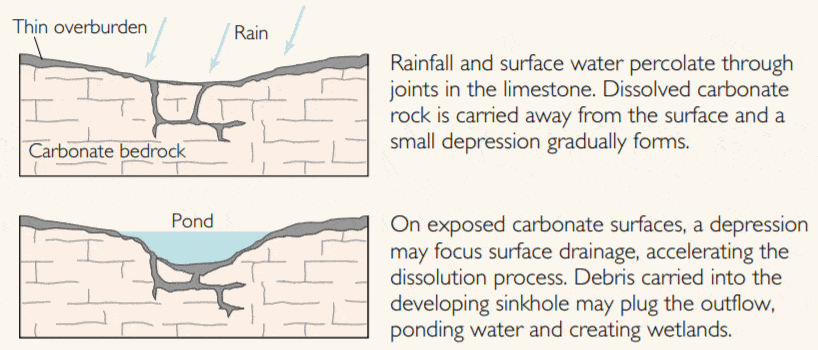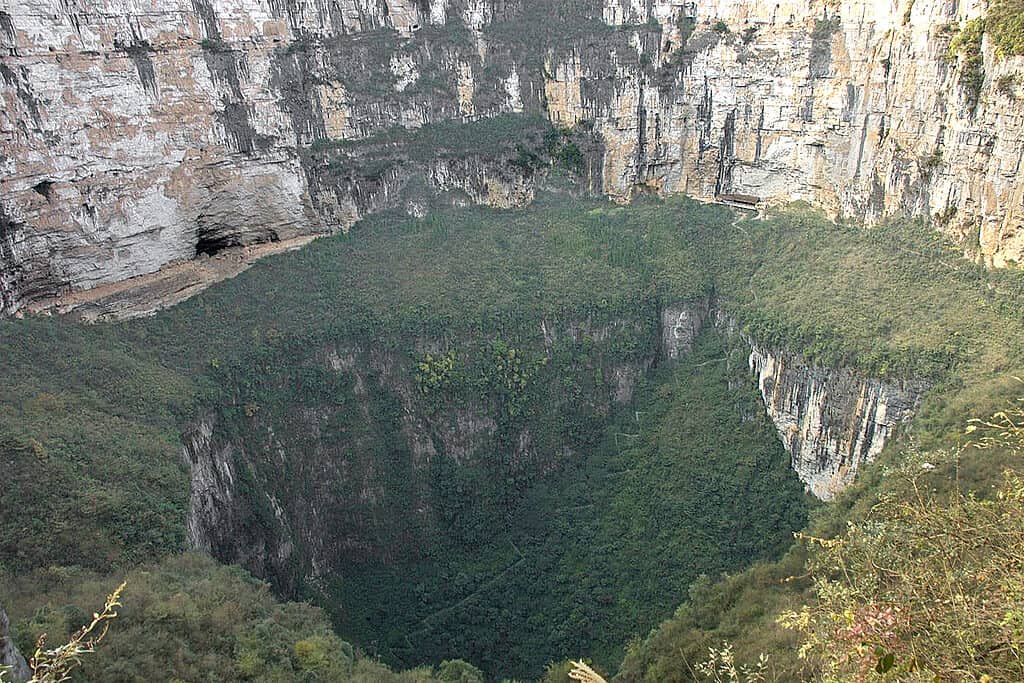Filmed in Bayou Corne, Louisiana, John Boudreaux captured the moment a massive underwater sinkhole opens up and swallows several trees. The amount of water that moves due to the sudden change in the depth of the bayou floor astounds onlookers. It appears a barrier was set up to mark the location of the hole, but it soon becomes disrupted as part of it follows the trees into the depths. Sinkholes are an incredible natural disaster that occurs worldwide, but why? Let’s look at this amazing video and then learn what causes sinkholes!
Watch the Amazing Sinkhole Swallow Up Trees Below!
What Causes a Sinkhole?
The U.S. Geological Survey (USGS) defines a sinkhole as “a depression in the ground that forms when groundwater circulates through rock and dissolves it.” In simpler terms, sinkholes form when water passes beneath an area of land (or down through it) and causes so much erosion that the land collapses in on itself. Let’s take a look at the three different types of sinkholes.
Dissolution

Dissolution sinkholes occur when the underlying rock dissolves.
©CC0 / Public Domain – License
These sinkholes form when water dissolves rock beneath the soil, causing a collapse. Some easily dissolvable rock types include salt, limestone, gypsum, and dolomite. The water flows into cracks naturally found in the rock and makes them bigger. Over time, they become so large the rock can no longer support the soil and the water, which results in a collapse. These sinkholes are very common in Florida. However, this type rarely causes severe or deep sinkholes that damage property. Many go unnoticed.
Cover-Subsidence

Cover-subsidence sinkholes occur in areas with sandy or clay-filled soils.
©CC0 / Public Domain – License
This sinkhole type occurs gradually in areas where the soil is largely comprised of sand or clay. As the rock layer dissolves, the granular cover layer slowly moves down into the cracks. Eventually, this shift in the surface material causes a shallow depression in the earth. This type is relatively uncommon are may be undetected for a longer period than others.
Cover-Collapse

Cover-collapse sinkholes are the most dramatic.
©CC0 / Public Domain – License
These sinkholes are the most commonly reported as they tend to cause the most significant damage and can occur in just a few hours. This type usually forms in areas with a large amount of clay in the soil. Over time, the surface drainage of water erodes the rock below, allowing sediment to move down into the resulting channels (called “spalling”). This process allows the depression to become a steep-walled cavity as the area continues to dissolve below the surface. The cavity moves progressively upward and downward at the same time. Once it expands enough to break through the surface, a sudden and dramatic collapse occurs.
What is the Largest Sinkhole Ever Recorded?

The largest sinkhole in the world is Xiaozhai Tiankeng in China.
©1,500 × 1,000 pixels, file size: 1.94 MB, MIME type: image/jpeg – License
This natural disaster happens all around the world. We hear about them on the news and watch their astonishing force take down cars, buildings, and more. You’re likely hankering to know, what’s the largest one in the world?
The title of largest sinkhole in the world goes to Xiaozhai Tiankeng in China. This incredible natural phenomenon boasts a size of more than 2,000 feet long, 1,762 feet wide, and almost 2,200 feet deep!
Xiaozhai Tiankeng is the largest in the cluster of magnificent sinkholes in the Shaanxi Province of China. This amazing natural disaster was known to China long before British explorers discovered it in 1994.
Scientists contribute the depth of the hole to its development over the Difeng Cave. A river still runs at the bottom of this astronomically sized sinkhole. The area is home to the critically endangered Chinese giant salamander and clouded leopards.
The photo featured at the top of this post is © iStock.com/Chris LaBasco
Thank you for reading! Have some feedback for us? Contact the AZ Animals editorial team.






